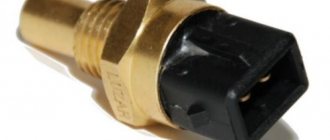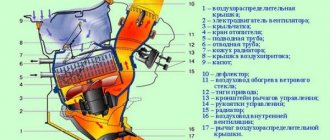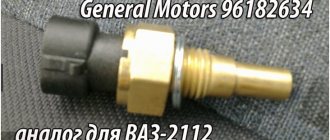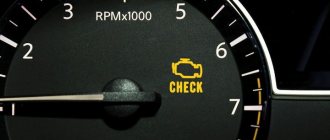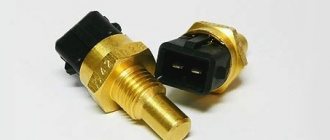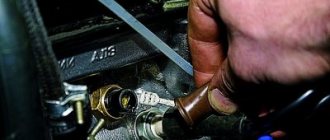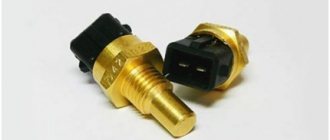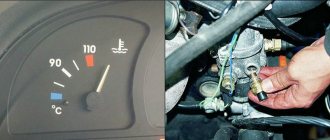Good luck to all readers of my blog. Today I’ll talk about how you already guessed about the temperature sensor. And so I want to tell you! Sometimes some comrades wonder: Why did their car suddenly start having difficulty starting? Either it doesn’t start at all. Or it starts but it hesitates like an epileptic. In short, there are many options. And the reason could be a small temperature sensor, which is located in the thermostat housing. Owners of cars with standards E-3 and higher have one sensor. And owners of older cars will see two sensors there. So the one with two contacts can soar the brain in the literal and figurative sense. After all, it is from this sensor that the ECU receives its “brain” a signal to prepare the mixture. And if a faulty sensor gives incorrect information, then the mixture will either be enriched or lean, so much so that the car will behave in a strange way))))) And it would seem that what’s so terrible about the fact that the sensor has flown? I went to any GAZ store and bought a temperature sensor. But it’s not that simple. There are several types of sensors on sale for the 405,406,409 family of engines. And they are all different.
Well, in appearance, of course, they are not very different, but they definitely give different impulses. Although in appearance there are still small differences. Such as size and color. Well, if everything is more or less clear with the size, then what does the color have to do with it? And despite the fact that these sensors are different not only in color, but also in markings.
The ZMZ-409 engine control system uses two identical temperature sensors 19.3828 - a coolant temperature sensor and an air temperature sensor. Checking the serviceability of temperature sensors, as a rule, is carried out in cases of difficulty starting the engine or when it is impossible.
The temperature sensor is a semiconductor zener diode, which is powered by a constant operating current from a stabilized source of the control unit. The output voltage of the sensor varies depending on the ambient temperature. As the temperature increases, the output voltage of the sensor increases. Both sensors are identical and polar in connection circuit, that is, their reverse connection is equivalent to an open circuit condition.
Sensor 19.3828 coolant temperature.
Installed in the thermostat housing and connected to the controller input, connected to an internal 5 Volt voltage source through a 2 kOhm resistor. Information from this sensor allows you to adjust the basic engine control parameters depending on its thermal state, since the coolant temperature affects most of the characteristics controlled by the controller.
Spark plugs used on cars with ZMZ-405, 406 and 409 engines
Before you go to the store to buy spark plugs (SZ) for injector engines 405, 406 or 409, you need to read the service book for the car. The manual must clearly indicate the SZ models, the operation of which is allowed in such motors. The manufacturer officially recommends using SZ A14DVR or their analogues. If you decide to give preference to analogues, then keep in mind that the spark gap in the spark plugs should be 0.7-0.85 mm.
Some motorists, leaving reviews on the Internet, recommend using the SZ A17DVRM, but this is not allowed for two reasons:
- first of all, these products have a different heat dissipation parameter;
- In addition, their gap is 1 mm, and this is not suitable for these engines.
Finding A14DVR devices today is not so easy, so many car enthusiasts have to look for analogues.
So that you can choose a similar product, we suggest that you familiarize yourself with the decoding in more detail:
- A - this beech determines the diameter, as well as the pitch of the thread D. The original SZ uses an M14 * 1.25 thread.
- 14 is the value of the heat number. It is considered one of the main parameters that determine the characteristics of the temperature regime of the product.
- D is the value of the thread length. In our case, the SZ are equipped with a thread 19 mm long.
- B - determines how much the thermal cone of the insulator protrudes into the combustion chamber of the motor itself. Thanks to the protrusion of the cone, the product warms up faster when starting the power unit, and this, in turn, ensures its higher resistance to soot formation.
- The last symbol - P - determines the presence of a built-in resistor element in the SZ design. Thanks to the presence of a resistor, the level of interference for radio equipment, as well as the motor control module, is reduced. In general, the presence or absence of this element in the design of the SZ will not in any way affect the functionality and quality of spark formation when starting the internal combustion engine.
Replacement intervals and signs of malfunction
On average, the service life of modern SZ is about 20 thousand kilometers. Of course, this indicator depends on many conditions. First of all, this is the quality of the completed part, its operating conditions, as well as the quality of the fuel used. The last point is very important, since the use of low-quality fuel will lead to a significant reduction in the service life of the SZ.
What are the signs of faulty spark plugs?
- If you remove the SZ from its seat, you will see its body. The presence of soot and deposits on the device body, in particular on the electrode, may indicate a breakdown of the product. You can try to solve such a problem by cleaning, but this does not always help.
- Presence of oil traces on the SZ. Due to oil exposure, the product cannot work efficiently, so problems may occur in the operation of the SZ. Such devices need to be cleaned and dried, but before further use it is necessary to determine the reason for the contact of motor fluid with them.
- Also, fuel traces on the devices may indicate a malfunction of the SZ.
- Another sign is that the starter has to be turned for a long time, and the engine may start after a long period of time, or may not start at all. The same symptoms indicate a dead battery, a broken distributor, or an incorrectly functioning fuel pump.
- When the engine warms up, unpleasant and uncharacteristic sounds appear. They may also appear when idling.
- Fuel consumption during vehicle operation has increased significantly.
- In addition, the volume of harmful substances in exhaust gases has increased. Of course, this malfunction cannot be determined by eye; a more thorough diagnosis is required.
- The vehicle's traction has weakened significantly, its power has decreased, and the engine has difficulty picking up speed.
Expansion tank Priora for VAZ 2110
One of the elements of the engine cooling system is the expansion tank. There are many reasons why it should be replaced, for example, the tank burst due to increased pressure in the system, or simply got old. In this photo report we will figure out whether it is possible to replace the expansion tank of a VAZ 2110 with a Priora tank .
Signs of malfunction of coolant temperature sensors: top common causes
This element is often a headache for drivers: if the engine temperature rises and the engine does not cool, then first of all it is necessary to check the functionality of the TOZ sensor. Factors that precede the breakdown of the antifreeze temperature indicator in the engine are:
- Text on the car’s on-board computer and the check lamp on the dashboard lights up;
- Flashing of the temperature sensor warning lamp on the instrument panel;
- Problem starting the engine, despite the degree of warm-up of the power unit or the ambient temperature;
- A sharp change in exhaust gases in the engine;
- Difficulties when restarting the power unit;
- Spontaneous engine stalling, regardless of its load level;
- Increased fuel consumption.
Antifreeze red, green, blue, what's the difference?
| Those who independently service their car know that antifreeze or antifreeze can have different colors. Sellers in stores advise adding coolant (coolant) to the tank only of the same color. Let's figure out whether it is possible to mix colors and what is the difference between red antifreeze and green.. |
Checking the spark plugs yourself
According to the wiring diagram for engines 405, 406 and 409, spark plugs are used to transfer spark from the switchgear to the engine cylinders. If the operation of the SZ is disrupted, this may affect the quality of the motor as a whole.
To check devices you will need an assistant:
- You need to disconnect the high-voltage wire from the first SZ.
- Using a key, the product is unscrewed from its seat.
- One end of the device from the electrode side should be brought to the engine or metal on the car body, the distance between the electrode and the ground should be about 1-2 mm.
- The assistant then turns the starter to try to start the engine. If at the moment of cranking a spark jumps between the electrode and the body, this indicates that the product is operational. In the same way, you need to check each SZ. Please note that problems with spark supply can also be caused by improper operation of the distributor, as well as damage to high-voltage wires.
Possibility of improvement
The ZMZ-409 design includes an oil cooler that reduces the temperature of the lubricant in the engine sump. The disadvantage of the design is a drop in oil pressure and excessive cooling of the oil in winter. To ensure temperature uniformity, a liquid-oil heat exchanger (LOH) from imported passenger cars is installed instead of the radiator. For modification, it is necessary to purchase an additional fitting for the UAZ Patriot oil filter from the ZMZ-514 diesel unit.
The fitting is modified in accordance with the dimensions of the hole in the liquid coolant; in order to press the heat exchanger to the cylinder block, it is necessary to roll a thread on the surface of the fitting. The radiator is mounted in place of the standard oil temperature valve, and then the housing of the replacement fine filter is attached. Antifreeze is supplied to liquid metal parts from the heat exchangers of the heating system (or from the gas reducer, if gas-cylinder equipment is installed on the machine).
Since the modernization involves disconnecting the standard intake of fluid for heating the interior from the cylinder block, the hole is plugged with a metal cover with 2 bolts.
An additional tube connecting the thermostat and the expansion tank is removed from the cooling circuit (used to remove vapors and part of the antifreeze). The remaining holes in the metal body and plastic tank are plugged, the modification allows eliminating the places of constant antifreeze leakage on the UAZ Patriot with mileage.
Features of the ignition coil device
The ignition coil (IC) is a small-sized transformer. A primary winding is wound on its magnetic core, and a secondary winding is installed on top of it, in sections. Both of them are installed in a plastic case, and the space between these components is filled with thermoactive polymer resin.
Also on the case there are low and high voltage contacts for connecting the device. In accordance with the coil connection diagram, low voltage pulses are supplied to the device from the control module. Once inside the device, these pulses are converted into high-voltage charges, which, in turn, are supplied to the SZ. The discharge is carried out simultaneously on two SZ (the author of the video is Alexander Terekhin).
How to check short circuit?
How to check the short circuit yourself:
- First, disconnect the power cable from the negative terminal of the battery and turn off the ignition.
- Then open the hood and disconnect the two high-voltage cables from the product. Unscrew the bolts and also dismantle the bar along with the product. The second short circuit is dismantled in a similar way.
- The diagnostic procedure itself is carried out using an ohmmeter; its probes are connected instead of disconnected wires. After connecting the probes, it is necessary to measure the resistance level. If the product is operational and in good working order, then the resistance level should be about 0.4-0.5 Ohm.
- To obtain more accurate diagnostic data, you can also short-circuit the tester probes, and then perform resistance diagnostics again. In particular, you are now interested in the secondary winding of the device. If the device is operational, then the resulting value should be around 5-7 kOhm. If the diagnostics showed different values, this indicates that the short circuit needs to be replaced.
Photo gallery “Short circuit diagnostics”
Maintenance
In order for this motor to work properly to the delight of its owner, it is necessary to carry out regular maintenance. Then, if this condition is met, the engine will have high performance. For this unit you need to use only high-quality fuel and lubricants.
All engine and vehicle systems need to be maintained and maintained. Only under such conditions will the motor last a long time and work without breakdowns. It is necessary to regularly check the oil and coolant levels, and the tension of the cooling pump belts.
In order for the engine to operate reliably, it is imperative to take care of the power system. Only with regular maintenance can stable operation be achieved. You need to be sure that all fuel line connections are secure, and you also need to clean the fuel injectors from time to time.
Typical unit malfunctions and ways to eliminate them
A malfunction in the operation of the short circuit can occur for the following reasons:
- There is a short circuit within the system, which may cause the device to overheat. If the operating temperature exceeds 150 degrees, the product will fail irrevocably.
- The second reason is a faulty power supply from the car's electrical network. As you know, for normal operation of electrical devices, the voltage level in the on-board network must be at least 11.5 volts. If the power is too low, it will take much longer to charge the short circuit.
- The device may also fail due to mechanical damage to the insulation. This problem is usually associated with engine fluid entering through worn out seals.
- Poor contact of the product with the on-board network. If the short circuit housing is damaged, this may cause moisture to enter the primary or secondary windings, which in turn can lead to the appearance of transition resistance.
- Thermal problems. Some short circuit models are more susceptible to heat generation than others, which can also affect their service life.
- As a result of exposure to engine vibrations, the performance of the short circuit may also be impaired.
Why is modernization necessary?
It is worth immediately noting that altering the cooling system of the VAZ 2114 is not a prerequisite for the normal operation of the car.
Its main goal is to achieve maximum comfort in the car interior in both hot and cold weather. It will help avoid excessive heat or cold inside the car and eliminate sudden temperature changes (typical, by the way, for all other AvtoVAZ cars - after all, they all have a cooling system built on the same general principle).
Many consider the most likely cause of poor system performance to be the radiator, which really does not have a high throughput; others blame the pump (and in some cases it is actually the culprit).
But, as serious research has shown, the main reason for poor performance of the cooling system is its thermostat. After all, it is this part that is responsible for uniformly heating the water and protecting it from excessive heating or freezing.
Modifying the thermostat switching system according to the diagram below will help avoid such troubles as:
- Long heating of the interior after parking.
- Temperature fluctuations while driving.
- Poor cooling in the summer heat.
- Uneven heating of the interior.
Replacing the temperature sensor
Let's consider the UAZ Patriot 409 engine with the Euro-3 environmental system. For repairs you will only need one key, size 19.
Both sensors are connected directly to the on-board network, therefore, in order to prevent an electrical short circuit, it is recommended to de-energize the car by “resetting” the negative terminal from the battery terminal.
The coolant temperature sensor is in direct contact with the refrigerant, therefore, to avoid liquid leaks, it is recommended to partially drain the antifreeze from the circuit. To do this, unscrew the plug on the engine block and make a partial selection of the refrigerant into a small container that can hold about 2 liters.
Cooling system design
UAZ Patriot SUVs with a ZMZ-409 gasoline engine use a closed cooling circuit with a radiator located in the front of the body. To supply air through the heat exchanger honeycombs, a fan with a viscous coupling is installed, which allows the performance to be adjusted depending on the degree of heating of the antifreeze. For refilling, a liquid of the Tosol-A40M type or analogues having a crystallization temperature not higher than -40°C is used. Antifreezes with a pour point of -65°C (for example, Tosol-A65M) are intended for arctic conditions.
To connect the engine jacket to the radiator and heat exchanger of the interior heater, reinforced elastic hoses secured with clamps are used.
Early series Patriot vehicles had copper heat exchangers installed, but after a series of tests the design became aluminum. In the radiator and expansion tank of the UAZ Patriot
There are plugs with steam valves that are activated when the power unit overheats. Antifreeze vapors are released into the atmosphere, preventing rupture of hoses or heat exchangers under the influence of excess pressure.
Instructions for connecting short circuit
The ZMZ 405, 406 and 409 engines use two short circuits - one of them works with cylinders 1 and 4, and the second with cylinders 2 and 3. The first of them is located closer to the intake manifold, and the second is located next to the exhaust manifold. To make the connection correctly, low voltage wires should be connected in pairs - those used for the first coil (cylinders 1-4) will be shorter in length. Since the short circuits themselves are not polar, it does not matter which contact the cable will be connected to; it also does not play a role within the pair to which cylinder the wire will be connected (the author of the video is the SpawnyXC90 channel).
How to make a smooth control unit for a radiator fan on a VAZ
| In this article I want to share the experience of my own development of an adaptive electric fan cooling controller for injection and carburetor VAZs. There are already several similar options on the market, and probably the most popular of them is the Borey controller, manufactured by . The device described in this article works in a similar way. Let's call it “Reliable cooling fan controller for VAZ2110 based on Arduino (development experience).” |
This is interesting: Stand for cylinders: maintenance
Emergency modes of the ECU, the nature of operation of the ZMZ-409 engine in these modes.
In the event of a breakdown or some malfunction of individual components or sensors of the ZMZ-409 engine management system, the electronic control unit (ECU) turns on the “Check Engine” lamp and goes into one of the emergency engine control modes.
If this happens, then until the system malfunction is completely eliminated, it is recommended to completely stop the car or, in extreme cases, drive at speeds of up to 50 km/h to prevent possible overheating or detonation of the engine, as well as failure of the exhaust gas converter.
The influence of the components of the electronic engine control system on its performance is different. For example, failure of the crankshaft position sensor or electric fuel pump. lead to complete inoperability of the ZMZ-409 engine.
But for example, if the coolant temperature sensor fails, the ECU simply starts taking its values equal to the temperature of a cold engine, and then after 3-5 minutes of operation it sets this value equal to the temperature of a warm engine. However, this may not be implemented in all firmware versions, so sometimes cold starts due to a malfunction of the temperature sensor are difficult or impossible.
Emergency modes of the ECU, the nature of operation of the ZMZ-409 engine in these modes.
1. Failure of the mass air flow sensor (MAF) or its circuit - difficult starting, increased idle speed, jerks and dips, loss of power and throttle response, increased fuel consumption, overheating of the converter.
2. Failure of the throttle position sensor (TPS) or its circuit - unstable or floating idle, loss of throttle response, dips and jerks.
3. Failure of the coolant temperature sensor (DTOZH) or its circuit - difficult cold start, increased idle speed, engine overheating, increased fuel consumption, jerks and dips.
4. Failure of the air temperature sensor (ATS) or its circuit - increased fuel consumption, detonation of a hot engine, jerks and dips.
5. Failure of the knock sensor (DS) or its circuit - engine detonation, jerking and dips, loss of throttle response.
6. Failure of the control oxygen sensor (OC) or its circuit - loss of throttle response, increased consumption, unstable idle.
7. Failure of the rough road sensor (RSD) or its circuit - jerks and dips on rough roads.
8. Failure of the crankshaft position sensor (CPS) or its circuit, damage to the synchro disk - the engine does not start, jerks and dips, unstable idling, detonation, engine stalling.
9. Failure of the camshaft position sensor (CPS) or its circuit - paraphase fuel injection, increased consumption, unstable idling, jerking and dips.
10. Failure of the immobilizer or its circuits, failure of the transponder or communication coil - the engine does not start, the “Check Engine” lamp is flashing.
11. Failure of a two-terminal ignition coil or one of the channels of the ignition module, or their circuits - interruptions in the operation of two cylinders, loss of power and throttle response, unstable idling, possible overheating of the converter.
12. Failure of an individual ignition coil or its circuit - interruptions in the operation of one cylinder, tripping, unstable idling, loss of power and throttle response, possible overheating of the converter.
13. Failure of the electronic control unit or its wiring harness - inoperability of the control system and engine, failure of sensor channels, loss of accuracy of parameter control, accumulation of erroneous adaptive data.
Why is car throttle heating needed?
| The throttle valve (VV) regulates the flow of air that enters the cylinders. To prevent it from freezing (especially on the highway), the manufacturer has equipped the throttle body with heated coolant. Many car enthusiasts believe that this is a useless feature and remove it completely. And others turn off the throttle heating only for the summer. Is there any point in such a simple modification? |
Basic aspects of ignition installation
The main aspects to consider when installing the ignition by marks:
- First, you need to dismantle the front cylinder head cover; to do this, you need to unscrew four 12-point screws. In some engine modifications, dismantling also involves removing the fuel pump.
- Then the upper hydraulic tensioner located in the head is dismantled; to do this, two screws securing the cover are unscrewed.
- Next, the chain stabilizers are removed - the middle one, as well as the top one; for this, the two screws that secure them are unscrewed.
- After this, the camshaft sprockets are dismantled. The shafts themselves need to be fixed using a 27 key, while simultaneously unscrewing the screws that secure them. In modifications of engines 4063.10, the camshaft sprocket is removed along with the fuel pump drive eccentric.
- In accordance with the jig installed on the sprocket, six holes should be drilled in each of them. Their angular displacements should be 2, 30, 5, 00, 7 and 30 degrees from the set position of the factory hole, which is located along the axis of symmetry.
- If, when adjusting the phases, it is necessary to turn the camshaft clockwise, the sprocket itself should be mounted on one of the additional holes with a positive offset. It is located to the right of the standard hole.
Spare parts for ZMZ-406 engines
Zavolzhsky Motor Plant began production of the ZMZ-406 engine family in 1997. The motor was actively used on cars such as Volga-3102, Volga-3110, Volga-31105, as well as on GAZelle and Sobol cars. The ZMZ-406 engine family includes the ZMZ-4062.10 engines - an injection version, and the ZMZ-4061.10 and ZMZ-4063.10 - carburetor versions.
The engines of the ZMZ-406 family have a 4-cylinder in-line liquid-cooled engine with controlled fuel injection, hydraulic pushers, a two-stage chain drive of two camshafts, and an electronic fuel injection and ignition control system.
Number of cylinders: 4 Power: 145 hp at 5200 rpm. Engine capacity: 2,286 cc cm Torque: 201 N.m at 4000 rpm. Fuel: gasoline AI-92, A-76. Weight: 187 kg.
On the website you can buy spare parts for ZMZ-406 in the catalog of spare parts for the ZMZ-406 engine. Our specialists will advise you and help you choose the necessary spare parts for the ZMZ-406 engine for your car. By purchasing spare parts from Dynamics 76, you are guaranteed to purchase high-quality spare parts for the ZMZ-406 engine.
Installation of the Grants thermostat on VAZ 2110, 2112
| It is no secret that the production of VAZ cars of the tenth family in Russia has already been completed. However, nothing prevents owners from improving their cars by replacing outdated parts with more modern ones, from foreign cars or VAZs of the latest years of production. An example of this would be replacing a VAZ 2110 thermostat with a Lada Granta thermostat. |
